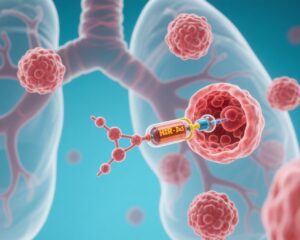Highlight
– Post-transplant cyclophosphamide (PTCy) combined with tacrolimus and mycophenolate mofetil effectively reduces acute and chronic graft-versus-host disease (GVHD) in mismatched unrelated donor (MMUD) peripheral blood stem cell transplantation (PBSC).
– Phase II trial demonstrates favorable 1-year overall survival (OS) exceeding 78% in both myeloablative and reduced-intensity conditioning groups.
– Use of MMUDs with PTCy-based prophylaxis significantly expands donor availability for patients, notably benefiting those from underrepresented racial and ethnic groups.
– Survival outcomes are comparable for patients with less than seven out of eight HLA allele matches compared to seven of eight matches, suggesting broader donor eligibility.
Study Background and Disease Burden
Allogeneic hematopoietic stem cell transplantation (HSCT) remains a cornerstone curative modality for patients with advanced hematologic malignancies, including leukemias and lymphomas. Success of HSCT depends significantly on human leukocyte antigen (HLA) compatibility between donor and recipient, minimizing immune-mediated complications such as graft-versus-host disease (GVHD). However, patients requiring transplantation frequently face challenges identifying optimally HLA-matched donors, particularly those from underrepresented racial and ethnic groups. These patients often rely on mismatched unrelated donors (MMUDs), historically linked with higher incidences of severe GVHD and reduced survival outcomes. Post-transplant cyclophosphamide (PTCy) has emerged as a potent GVHD prophylaxis strategy, especially in haploidentical transplants, by selectively eliminating alloreactive T cells post-engraftment. By reducing GVHD risk, PTCy may improve clinical results for MMUD PBSC transplants, but data specific to this setting—particularly prospective multicenter trials—has been lacking.
Study Design
This was a prospective, phase II, nonrandomized, multicenter clinical trial named ACCESS (ClinicalTrials.gov identifier: NCT04904588). It investigated the efficacy and safety of a GVHD prophylaxis regimen consisting of post-transplant cyclophosphamide, tacrolimus, and mycophenolate mofetil in adult patients undergoing allogeneic PBSC transplantation from HLA-mismatched unrelated donors. The study stratified patients into two conditioning intensity groups: myeloablative conditioning (MAC) and reduced-intensity/nonmyeloablative conditioning (RIC/NMA). The primary endpoint was 1-year overall survival (OS) within each conditioning cohort. Secondary endpoints included incidence rates of grades III-IV acute GVHD at 6 months, moderate to severe chronic GVHD at 1 year, and analysis of survival in relation to HLA matching degree. A total of 145 patients were enrolled across multiple centers with careful monitoring of GVHD, survival, and transplant-related toxicities.
Key Findings
A total of 145 transplant recipients were included, with 59% self-identifying as belonging to underrepresented racial or ethnic groups, highlighting the study’s emphasis on historically underserved populations. The 1-year OS was encouragingly high: 83.8% (95% confidence interval [CI] 73.1% to 90.4%) in the MAC group and 78.6% (95% CI 67% to 86.5%) in the RIC/NMA group.
Regarding graft-versus-host disease endpoints, incidence rates of severe acute GVHD (grades III-IV) at 6 months were low, reported as 8% (95% CI 3.2 to 15.6) in the MAC cohort and 10% (95% CI 4.4 to 18.4) in the RIC/NMA cohort. Moderate or severe chronic GVHD at 1 year was seen in 10.3% (95% CI 4.4 to 18.9) of MAC patients and 8.6% (95% CI 3.5 to 16.6) of patients receiving RIC/NMA conditioning. These incidences compare favorably to historical controls without PTCy-based regimens, which often show considerably higher GVHD rates with MMUD transplants using PBSC grafts.
An important observation was that 32% of patients had donors matched at fewer than seven out of eight HLA alleles. Remarkably, this subgroup experienced overall survival outcomes similar to those patients with seven out of eight HLA allele matches, indicating that PTCy prophylaxis can mitigate the adverse impact of greater HLA disparity.
The trial’s safety profile was consistent with expectations for this patient population, with no unexpected toxicities linked to the PTCy-based prophylaxis protocol. This regimen thus provides a promising approach to balancing graft-versus-leukemia effects and GVHD risk in the challenging setting of MMUD PBSC transplantation.
Expert Commentary
The ACCESS phase II trial adds critical prospective multicenter evidence supporting the use of PTCy in combination with tacrolimus and mycophenolate mofetil for GVHD prophylaxis after MMUD PBSC transplantation. The reported 1-year OS exceeding 78% across conditioning intensities and the low acute and chronic GVHD rates represent important advancements, as MMUD HSCT traditionally correlates with inferior outcomes. These findings suggest that selective in vivo depletion of alloreactive T cells by PTCy effectively controls alloimmune reactions, expanding the donor pool to patients who previously faced limited options due to lack of matched donors.
Clinicians must note that this regimen was studied in adult patients and that the trial was nonrandomized; thus, results warrant confirmation in randomized controlled studies. Additionally, while the study enrolled a diverse cohort reflecting underrepresented populations, real-world outcomes in specific ethnic subgroups may vary based on HLA polymorphisms and supportive care differences. Mechanistically, PTCy preferentially targets proliferating T cells shortly after transplantation, promoting immune tolerance without inhibiting graft-versus-tumor activity.
Current guidelines increasingly recommend PTCy-based prophylaxis for haploidentical transplantation, and these data support its extension to MMUD PBSC grafts. Future investigations should focus on refinement of dosing schedules, long-term immune reconstitution, and strategies to integrate with novel therapies such as immune checkpoint modulation.
Conclusion
The integration of post-transplant cyclophosphamide with tacrolimus and mycophenolate mofetil in the prophylaxis of GVHD after mismatched unrelated donor PBSC transplantation results in markedly improved 1-year overall survival and reduced rates of significant acute and chronic GVHD. This approach represents a critical advancement in allogeneic HSCT, particularly addressing disparities faced by patients lacking fully matched donors from diverse racial and ethnic backgrounds. Adoption of this regimen expands donor accessibility, thereby enabling potentially curative transplant options for a broader patient population. Ongoing studies will clarify long-term outcomes and further optimize GVHD prophylaxis paradigms.
References
Al Malki MM, Bo-Subait S, Logan B, et al. Post-Transplant Cyclophosphamide-Based Graft-Versus-Host Disease Prophylaxis After Mismatched Unrelated Donor Peripheral Blood Stem Cell Transplantation. J Clin Oncol. 2025 Sep;43(25):2772-2781. doi:10.1200/JCO-25-00856.
Additional literature on PTCy and GVHD prophylaxis strategies in allogeneic stem cell transplantation.



